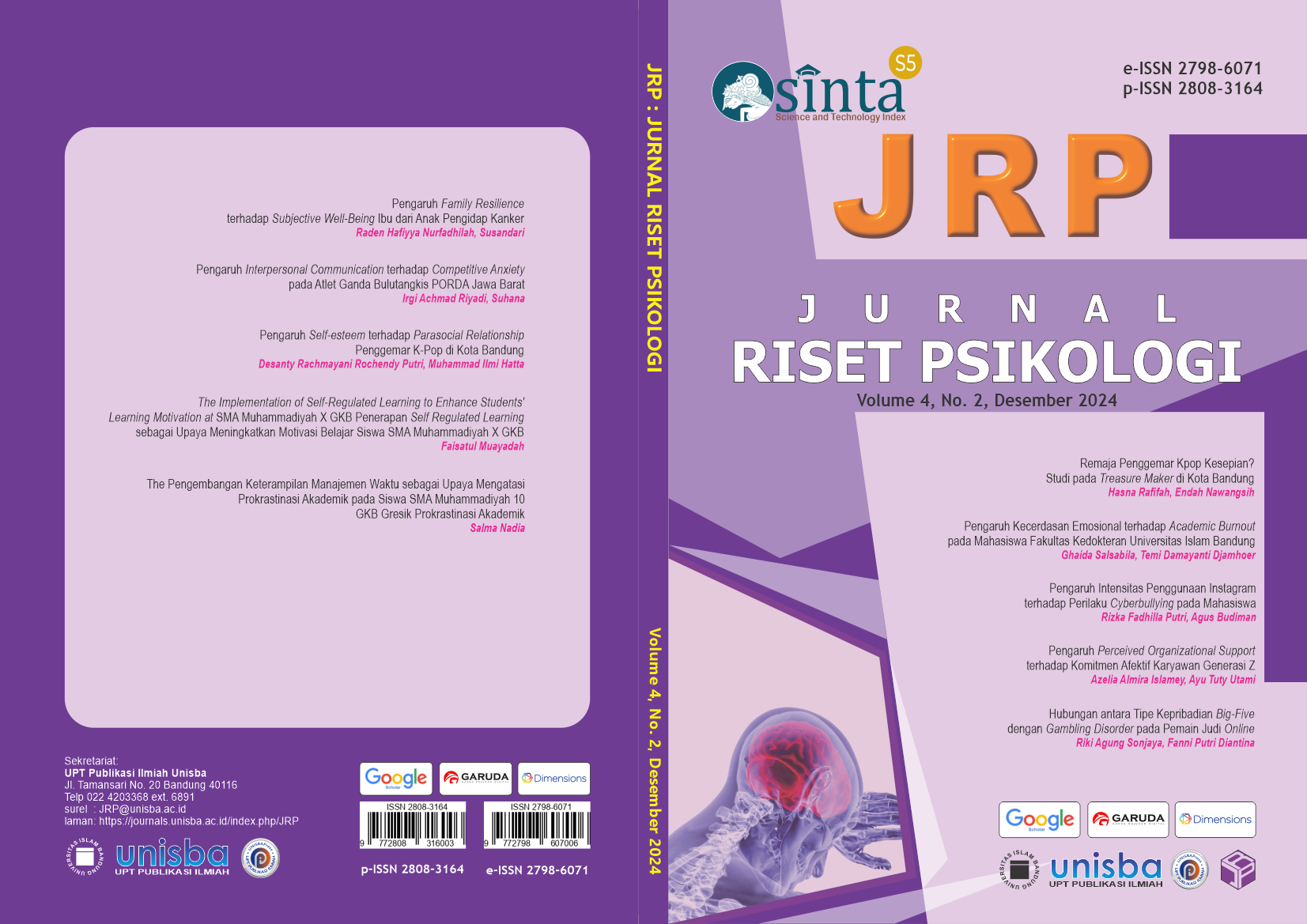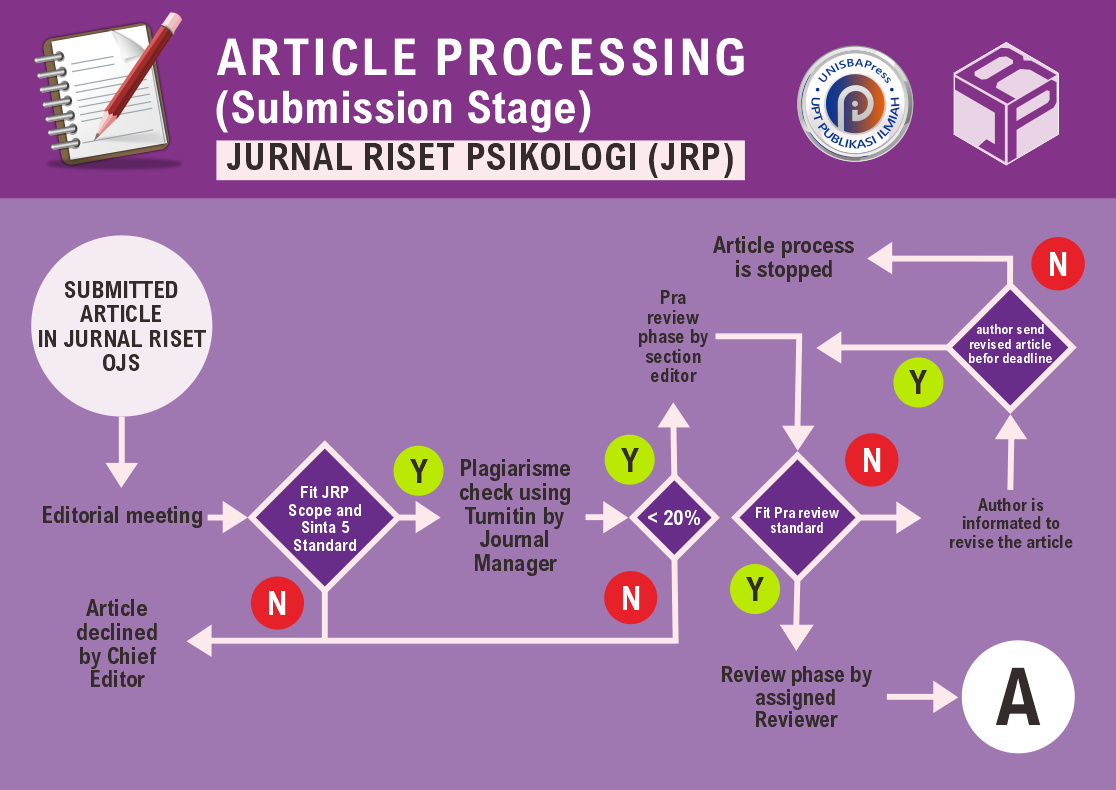Remaja Penggemar Kpop Kesepian? Studi pada Treasure Maker di Kota Bandung
DOI:
https://doi.org/10.29313/jrp.v4i2.5052Keywords:
Loneliness, Parasocial Relationship, Treasure MakerAbstract
Abstract. The rise of the “Korean Wave” targeting teenagers has led to a high number of K-Pop fans in their teens. The ongoing development of technology has presented a special platform for idols and fans that makes it easier for fans to access information about their idols, which can then foster feelings of attachment. Individuals who are less skilled in socializing, such as individuals with high levels of loneliness, tend to form parasocial relationships to be able to fulfill their social and friendship needs. This study aims to obtain empirical data on the relationship between loneliness and parasocial relationships in Treasure Maker users of Weverse Membership using quantitative methods and a sample size of 235 Treasure Maker users of Weverse Membership in Bandung City. The researcher used the UCLA Loneliness Scale Version 3 measuring instrument developed by Rusell (1996) and the Multiple Parasocial Relationship Scale (MPR-S) from Tukachinsky (2010). The results of the data analysis carried out using the Spearman Rank correlation technique, obtained a correlation coefficient value of 0.998 for parasocial friendship and 0.997 for parasocial love with a significance value of 0.000. The results show that H0 is rejected, meaning that there is a positive relationship between loneliness and parasocial relationships, the higher the loneliness, the higher the degree of parasocial relationship.
Abstrak. Maraknya “Korean Wave” dengan sasaran penyebaran remaja, menyebabkan tingginya angka fans K-Pop di usia remaja. Perkembangan teknologi yang terus terjadi menghadirkan platform khusus idola dan penggemar yang memudahkan para penggemar mengakses informasi mengenai idolanya, yang kemudian dapat menumbuhkan perasaan kelekatan. Individu yang kurang terampil dalam bersosialisasi seperti individu dengan tingkat kesepian yang tinggi, cenderung menjalin hubungan parasosial untuk dapat memenuhi kebutuhan sosial dan persahabatannya. Penelitian ini bertujuan untuk memperoleh data empiris dari hubungan antara loneliness dengan parasocial relationship pada Treasure Maker pengguna Weverse Membership dengan metode kuantitatif dan jumlah sampel 235 Treasure Maker pengguna Weverse Membership yang berada di Kota Bandung. Peneliti menggunakan alat ukur UCLA Loneliness Scale Version 3 yang dikembangkan oleh Rusell (1996) dan Multiple Parasocial Relationship Scale (MPR-S) dari Tukachinsky (2010). Hasil dari analisis data yang dilakukan dengan teknik korelasi Rank Spearman, didapatkan nilai koefisien korelasi sebesar 0.998 pada parasocial friendship dan 0.997 pada parasocial love dengan nilai signifikansi sebesar 0.000. Hasil tersebut menunjukkan bahwa H0 ditolak, artinya terdapat hubungan positif antara loneliness dengan parasocial relationship, semakin tinggi loneliness maka semakin tinggi derajat parasocial relationship.
References
S. Lee and A. M. Nornes, “Hallyu 2.0: The Korean Wave in the Age of Social Media,” in Introduction : A Decade of Hallyu Scholarship : Toward a New Direction in Hallyu 2.0, Amerika Serikat: University of Michigan Press, 2015.
D. A. Saifuddin and A. M. Masykur, “INTERAKSI PARASOSIAL,” Jurnal EMPATI, vol. 3, no. 4, pp. 143–152, Oct. 2014, doi: 10.14710/empati.2014.7568.
D. Horton and R. Richard Wohl, “Mass Communication and Para-Social Interaction,” Psychiatry, vol. 19, no. 3, pp. 215–229, Aug. 1956, doi: 10.1080/00332747.1956.11023049.
K. Hellekson and K. Busse, Fan Fiction and Fan Communities in the Age of the Internet: New Essays. North Carolina: McFardland, 2014.
C. L. Jarzyna, “Parasocial Interaction, the COVID-19 Quarantine, and Digital Age Media,” Human Arenas, vol. 4, no. 3, pp. 413–429, Sep. 2021, doi: 10.1007/s42087-020-00156-0.
M. Khairil, M. I. Yusaputra, and . N., “Efek Ketergantungan Remaja K-Popers Terhadap Media Sosial di Kota Palu,” Jurnal ASPIKOM, vol. 4, no. 1, p. 14, Aug. 2019, doi: 10.24329/aspikom.v4i1.484.
K. Wulandari, Sugandi, and Hairunnisa, “Interaksi Parasosial dan Tingkat Loyalitas Konsumen Remaja Akhir Penggemar Korean Pop (K-Pop) di Samarinda,” Management Studies and Entrepreneurship Journal (MSEJ), vol. 4, no. 2, 2023.
A. A. Desriana, “Pemaknaan Hubungan Parasosial Dan Kesepian Nctzen Pada Platform Weverse,” Universitas Medan Area , Medan, 2022.
R. Sanjaya and D. Rahmasari, “Self-Control of Kpopers Experiencing Celebrity Worship Syndrome,” Character Jurnal Penelitian Psikologi, vol. 10, no. 1, pp. 409–426, 2023.
A. Sagita and D. Kadewandana, “Hubungan Parasosial di Media Sosial: Studi pada fandom army di twitter,” CoverAge: Journal of Strategic Communication, vol. 8, no. 1, pp. 45–58, 2017.
J. Tsao, “Compensatory media use: An exploration of two paradigms,” Commun Stud, vol. 47, no. 1–2, pp. 89–109, Mar. 1996, doi: 10.1080/10510979609368466.
J.-E. Nordlund, “Media Interaction,” Communic Res, vol. 5, no. 2, pp. 150–175, Apr. 1978, doi: 10.1177/009365027800500202.
L. E. Berk, Development through the lifespan, Sixth Edition. 2014.
H. Guo, “Linking loneliness and use of social media,” University of Helsinki, 2018.
CNNIndonesia, “Survei: 98 Persen Orang Indonesia Kesepian di Masa Pandemi,” CNN Indonesia.
M. Luhmann and L. C. Hawkley, “Age differences in loneliness from late adolescence to oldest old age.,” Dev Psychol, vol. 52, no. 6, pp. 943–959, Jun. 2016, doi: 10.1037/dev0000117.
C. Klimmt, T. Hartmann, and H. Schramm, “Psychology of entertainment ,” in Parasocial Interactions and Relationships, J.Bryant & P.Vorderer., Lawrence Erlbaum Associates, 2006, pp. 291–313.
R. Tukachinsky, “Para-Romantic Love and Para-Friendships: Development and Assessment of a Multiple-Parasocial Relationships Scale,” Amerika Serikat, 2010.
D. W. Russell, “UCLA Loneliness Scale (Version 3): Reliability, validity, and factor structure.,” J Pers Assess, vol. 66, no. 1, pp. 20–40, 1996.













